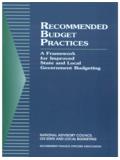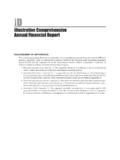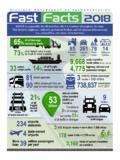Transcription of Tax-Exempt Financing: A Primer - gfoa.org
1 Tax-Exempt FINANCING: A Primer . Public Finance Network About the Public Finance Network Formed in 1988, the Public Finance Network is a coalition of 44 organizations united to preserve state and local government use of Tax-Exempt finance. Members of the Network represent virtually all segments of local and state governments. For information about the Network and financing issues, contact any of its members, listed in Appendix B, or call or write: Public Finance Network 1750 K Street, , Suite 350. Washington, 20006. 202/429-2750. Table of Contents Introduction .. iv Questions and Answers Chapter 1: Fundamentals of Tax-Exempt Financing.
2 1. Chapter 2: Constitutional and Policy Issues .. 6. Chapter 3: Congressional Actions and Their Effects .. 9. Chapter 4: Responses to Questions About Tax-Exempt Financing .. 16. Appendices A: Chronology of Federal Laws Affecting Tax-Exempt Financing .. 19. B: Who's Who in the Public Finance Network .. 26. iii Introduction Tax-Exempt Financing: A Primer provides those unfamiliar with this financing method with a basic understanding of the issue. The Primer is divided into two parts: a series of questions and answers on Tax-Exempt financing, followed by a summary of federal legisla- tion related to Tax-Exempt bonds in Appendix A.
3 The questions and answers are organized in four sections: Fundamentals of Tax-Exempt Financing Provides basic background and definitions essential to an understanding of Tax-Exempt financing;. Constitutional and Policy Issues Describes the effects of the Supreme Court's 1988. decision on Tax-Exempt financing and outlines the public policy issues to which Congress should be sensitive in deciding the future of Tax-Exempt financing;. Congressional Actions and Their Effects Highlights major changes in Tax-Exempt bond law, particularly those contained in the 1986 Tax Reform Act, the impact those changes have had on issuers of Tax-Exempt municipal bonds, and suggests changes to better enable state and local governments to meet their financing needs; and Responses to Questions About Tax-Exempt Financing Provides answers to some of the questions associated with the use of Tax-Exempt bonds.
4 This Primer was prepared by staff of the American Public Power Association (APPA) and the Government Finance Officers Association (GFOA) for the Public Finance Network (PFN). The PFN is a coalition of 46 organizations interested in preserving the Tax-Exempt status of state and local government bonds. A list of PFN members and contact names ap- pears in Appendix B. v Chapter 1. Fundamentals of Tax-Exempt Financing What is Tax-Exempt financing? Tax-Exempt financing is used by state and local governments to raise capital to finance public capital improvements and other projects, including infrastructure facilities that are vitally important to sustained economic growth.
5 State and local governments have three means of financing these projects: pay-as-you-go financing, intergovernmental revenues such as grants, and borrowing. Borrowing, or debt financing, is accomplished by issuing bonds to pay for specific projects or services. A bond is a debt instrument bearing a stated rate of interest that matures on a certain date, at which time a fixed sum of money plus inter- est is payable to the bondholder. Unlike corporate debt issues, the interest received by holders of state and local government bonds (also called municipal bonds) is exempt from federal income taxes and may also be exempt from state and local income taxes.
6 Consequently, investors will accept a lower inter- est rate on Tax-Exempt issues, which reflects their reduced tax burden. This lower rate re- duces borrowing costs for state and local governments by approximately 25 percent. What types of Tax-Exempt bonds are issued by state and local governments? There are two general categories of Tax-Exempt bonds: general obligation bonds and reve- nue bonds. General obligation bonds are backed by the full faith and credit of the state or local government that issues the bonds. This means the general taxing power of the jurisdic- tion is pledged to guarantee repayment of the debt.
7 Revenue bonds are issued for a specific project, such as an electric generating plant, and are paid for from the revenues received from the project. Because they are not backed by the full faith and credit of the issuer, rev- enue bonds generally pay a slightly higher interest rate than general obligation bonds to re- flect the fact they are backed by a particular stream of revenue. 1. 2 Tax-Exempt FINANCING: A Primer . Who may issue Tax-Exempt bonds? At the present time, Tax-Exempt bonds may be issued by a state or local government or by special units of government such as authorities, commissions, or districts, as well as by not-for-profit organizations such as hospitals and colleges.
8 These entities are created in ac- cordance with state law and are authorized by the state to issue debt. What do Tax-Exempt bonds finance? In 1998, $ billion worth of municipal bonds were issued, of which $ billion, or 89 percent, were long-term bonds and $ billion were short-term bonds. Of the more than $285 billion of long-term bonds, 56 percent were new issuances and 28 percent repre- sented refundings of previously issued bonds to take advantage of the lower interest rates, and 15 percent were combined issues. The following table lists the categories for which these long-term bonds were issued. The figures were compiled from data contained in The Bond Buyer 1999 Yearbook.
9 Long-Term Tax-Exempt Bond Issuance (Billions of Dollars). 1998. Category Amount Percent of Total Education $ 22. Utilities 8. Transportation 11. Health Care 14. Electric Power 5. Housing 7. Public Facilities 5. Environmental Facilities 4. Industrial Development 3. Other 21. Totals $ 100%. Who benefits from Tax-Exempt bonds? All citizens benefit from Tax-Exempt bonds. Tax-Exempt bonds are used to raise capital to meet the long-term needs of America's state and local governments. More specifically, Tax-Exempt bonds are issued by states and localities to build schools, roads, bridges, airports, public power facilities, sewers, hospitals, fire stations, affordable housing, mass transit facili- ties, colleges and universities, and most public facilities that citizens rely on regularly.
10 Although the primary beneficiaries of a particular bond issuance are the citizens of the issu- ing community, the whole is equal to the sum of its parts, and the nation as a whole has a Fundamentals of Tax-Exempt Financing 3. vital interest in maintaining adequate public facilities to support a dynamic economy. The national interest is well served by keeping state and local government borrowing costs low, thereby providing an incentive for public investment in infrastructure and other facilities. Who purchases Tax-Exempt bonds? Most Tax-Exempt bonds are Tax-Exempt Bondholders purchased by individuals.












